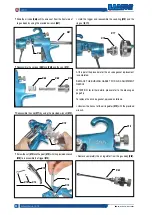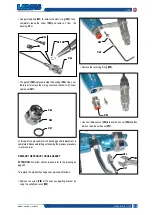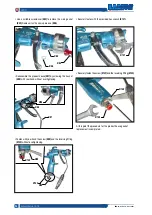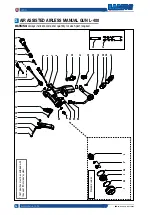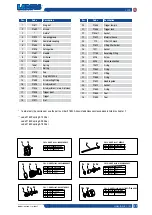
www.larius.com
12
L400
REV.
02 - 02/2020 - Cod. 150085
High pressure fluid in the hoses can be very dangerous. If the hose
develops a leak, split or rupture due to any kind of wear, damage
or misure, the high pressure fluid emitted from it can cause a fluid
injection injury or other serious injury or property damage.
• Tighten all fluid connections securely before each use. High
pressure fluid can dislodge a loose coupling or allow high
pressure fluid to be emitted from the coupling
• Never use a damaged hose. If any of these conditions exist,
replace the hose immediately.
• Do not try to recouple high pressure hose or mend it with tape
or any other device. A repaired hose cannot contain the high
pressure fluid.
• Handle and route hoses carefully.
Proper hose grounding continuity is essential to maintaining a
grounded dispensing system. Check the electrical resistance of
your fluid hoses at least once a week. If your hose does not have
a tag on it which specifies the maximum electrical resistance,
contact the hose supplier or manufacturer for the maximum
resistance limits.
Use a resistance meter in the appropriate range for your hose to
check the resistance. If the resistance exceeds the recommended
limits, replace it immediately. An ungrounded or poorly grounded
fluid hose can make your system hazardous.
Any misuse of the dispensing equipment or accessories, such as
overpressurizing, modifying parts, using incompatible chemicals
and fluids, or using worn or damaged parts, can cause them to
rupture and result in serious injury, including fluid injection and
splashing fluid in the eyes or on the skin, or in fire, explosion or
property damage.
Be sure that all dispensing equipment and accessories are
properly rated to withstand the pressures developed by your
system. Never exceed the maximum working pressure of your
gun model.
EQUIPMENT MISUSE
HAZARD
L
The maximum working pressure of the gun is
110 bar. Do not exceed the maximum Working
pressure.
HOSE SAFETY
M
Before each use, check the entire hose for cuts,
leaks, abrasion, bulging cover, or damage or
movement of the hose couplings.
Do not pull on hoses to move equipment.
Do not use fluids or solvents which are not
compatible with the inner tube and cover of
the hose.
Do not expose hose to extreme temperatures;
check with your hose supplier to determine
temperature tolerance.
If you suspect that the nozzle or hose is clogged
or that pressure has not been fully relieved, after
following the steps above, very slowly loosen the
hose end coupling and relieve pressure gradually;
then loosen completely. Now clear the nozzle or
hose obstruction.
Be sure all fluids and solvents used are chemically
compatible with the “WETTED PARTS” shown in
the TECHNICAL DATA. Always read the fluid and
solvent mnufacturer’s literature before using any
fluid or solvents in your system.
Static electricity is created by the flow of fluid through the pump
and hose. If every part of the equipment is not properly grounded,
sparking may occur, and the system may become hazardous.
Sparks may also occur when plugging in or unplugging a power
supply cord. Sparks can ignite fumes from solvents and the fluid
being dispensed, dust particles and other flammable substances,
whether you are pumping indoors or outdoors, and cause a fire
or explosion, serious injury, and property damage.
FIRE OR EXPLOSION HAZARD
N
Do not plug in or unplug any power supply cords
in the dispensing area when there is any chance
of igniting fumes still in the air.
If you experience any static sparking or feel even
a slight shock while using this equipment, STOP
DISPENSING IMMEDIATELY. Check for proper
grounding of the entire system. Do not use the
system again until the cause of the problem is
identified and corrected.






















